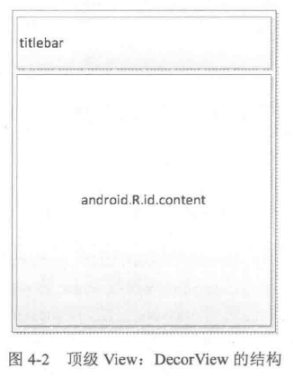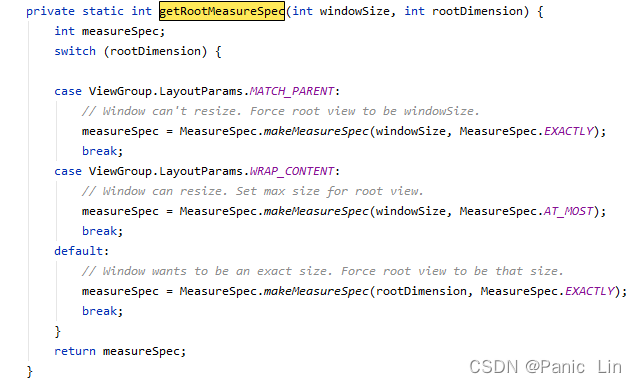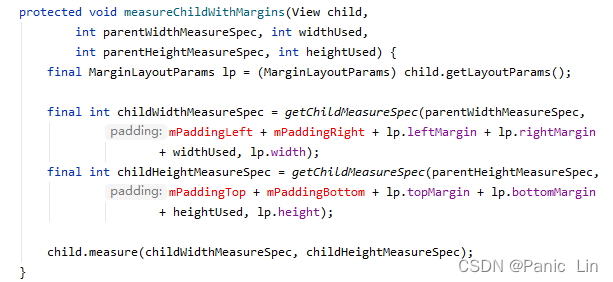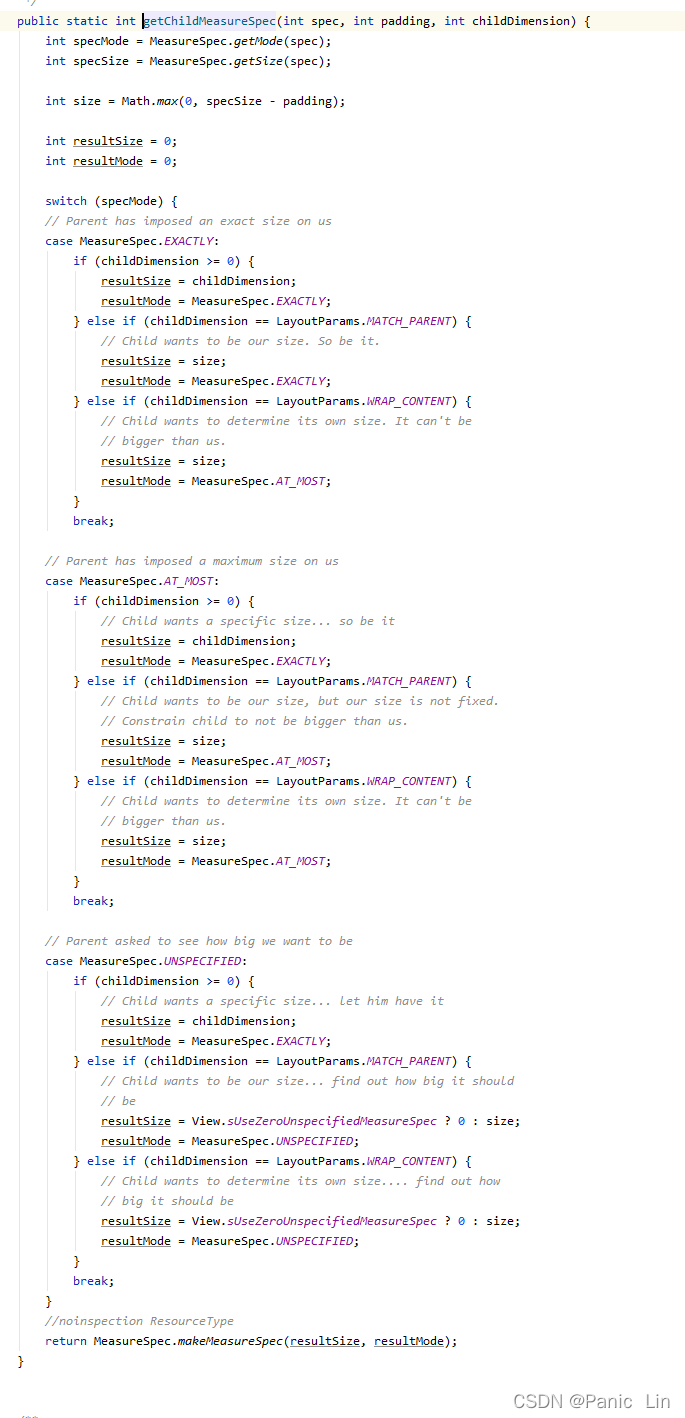初识ViewRoot和DecorView
ViewRoot对应于ViewRootImpl类,它是连接WindowManager和DecorView的纽带,View的三大流程均是通过ViewRoot完成。在ActivityThread中,当Activity被创建完毕后,会将DecorView添加到Window中,同时会创建ViewRootImpl对象,并将ViewRootImpl对象和DecorView建立关联。

View的绘制过程是从ViewRoot的performTraversals方法开始的,它经过measure、layout和draw三个过程才能最终将一个View绘制出来,其中measure用来测量View的宽和高,layout用来确定View在父容器中的放置位置,而draw则负责将View绘制在屏幕上。

在上图中,performTraversals会依次调用performMeasure、performLayout和performDraw三个方法,这三个方法分别完成顶级View的measure、layout、draw三大流程。其中在performMeasure中又会调用measure方法,在measure中又会调用onMeasure方法,在onMeasure中会对所有的子元素进行measure过程,这个时候measure流程就从父容器传递到子元素中了,这样就完成了一次measure过程。接着子元素会重复父容器的measure过程,如此往复就完成了整个View的遍历。同理,layout和draw流程和它都是类似的。唯一不同的是performDraw的传递过程是在draw方法中通过dispatchDraw来实现的。
measure过程决定了View的宽高,Measure完成后,可以通过getMeasuredWidth和getMeasureHeight方法来获取到View测量后的宽高,在几乎所有的情况下它都等同于View的最终宽高。
layout过程决定了View的四个顶点的坐标和实际View的宽高,完成以后可以通过getTop,getBottom,getLeft,getRight来拿到View的四个顶点的位置,并可以通过getWidth和getHeight拿到View的最终宽高。
draw过程则决定了View的显示,只有draw方法完成以后View的内容才能呈现在屏幕上。

如上图,DecorView作为顶级View,一般情况下它内部会包含一个竖直方向的LinearLayout,在这个LinearLayout里面右上下两个部分(和Android版本及主题有关),上面是标题栏下面是内容。在Activity中我们通过setContentView所设置的布局文件其实就是被加到内容栏之中的,而内容栏的id是content,因此可以理解为Activity指定布局的方法不叫setview而叫setContentView,因为我们的布局的确加到了id为content的FrameLayout中。
如何得到content?
ViewGroup content=findViewById(R.android.id.content)
如何得到我们设置的View?
content.getChildAt(0)

通过源码我们可以发现DecorView是一个FrameLayout,View层的事件先经过DecorView再传递到我们的View。
MeasureSpec
MeasureSpec很大程度上决定了一个View的尺寸规格,之所以说是很大程度上是因为这个过程还受父容器的影响,因为父容器影响View的MeasureSpec的创建过程。在测量过程中,系统会将View的LayoutParams根据父容器所施加的规则转换成对应的MeasureSpec,然后再根据这个MeasureSpec来测量出View的宽高。这里的宽高指的是测量宽高,不一定等于View的最终宽高。
MeasureSpec代表一个32位int值,高2位代表SpecMode,低30位代表SpecSize,SpecMode是指测量模式,而SpecSize是指在某种测量模式下的规格大小。
* A MeasureSpec encapsulates the layout requirements passed from parent to child.
* Each MeasureSpec represents a requirement for either the width or the height.
* A MeasureSpec is comprised of a size and a mode. There are three possible
* modes:
* <dl>
* <dt>UNSPECIFIED</dt>
* <dd>
* The parent has not imposed any constraint on the child. It can be whatever size
* it wants.
* </dd>
*
* <dt>EXACTLY</dt>
* <dd>
* The parent has determined an exact size for the child. The child is going to be
* given those bounds regardless of how big it wants to be.
* </dd>
*
* <dt>AT_MOST</dt>
* <dd>
* The child can be as large as it wants up to the specified size.
* </dd>
* </dl>
*
* MeasureSpecs are implemented as ints to reduce object allocation. This class
* is provided to pack and unpack the <size, mode> tuple into the int.
*/
public static class MeasureSpec {
private static final int MODE_SHIFT = 30;
private static final int MODE_MASK = 0x3 << MODE_SHIFT;
/** @hide */
@IntDef({UNSPECIFIED, EXACTLY, AT_MOST})
@Retention(RetentionPolicy.SOURCE)
public @interface MeasureSpecMode {}
/**
* Measure specification mode: The parent has not imposed any constraint
* on the child. It can be whatever size it wants.
*/
public static final int UNSPECIFIED = 0 << MODE_SHIFT;
/**
* Measure specification mode: The parent has determined an exact size
* for the child. The child is going to be given those bounds regardless
* of how big it wants to be.
*/
public static final int EXACTLY = 1 << MODE_SHIFT;
/**
* Measure specification mode: The child can be as large as it wants up
* to the specified size.
*/
public static final int AT_MOST = 2 << MODE_SHIFT;
/**
* Creates a measure specification based on the supplied size and mode.
*
* The mode must always be one of the following:
* <ul>
* <li>{@link android.view.View.MeasureSpec#UNSPECIFIED}</li>
* <li>{@link android.view.View.MeasureSpec#EXACTLY}</li>
* <li>{@link android.view.View.MeasureSpec#AT_MOST}</li>
* </ul>
*
* <p><strong>Note:</strong> On API level 17 and lower, makeMeasureSpec's
* implementation was such that the order of arguments did not matter
* and overflow in either value could impact the resulting MeasureSpec.
* {@link android.widget.RelativeLayout} was affected by this bug.
* Apps targeting API levels greater than 17 will get the fixed, more strict
* behavior.</p>
*
* @param size the size of the measure specification
* @param mode the mode of the measure specification
* @return the measure specification based on size and mode
*/
public static int makeMeasureSpec(@IntRange(from = 0, to = (1 << MeasureSpec.MODE_SHIFT) - 1) int size,
@MeasureSpecMode int mode) {
if (sUseBrokenMakeMeasureSpec) {
return size + mode;
} else {
return (size & ~MODE_MASK) | (mode & MODE_MASK);
}
}
/**
* Like {@link #makeMeasureSpec(int, int)}, but any spec with a mode of UNSPECIFIED
* will automatically get a size of 0. Older apps expect this.
*
* @hide internal use only for compatibility with system widgets and older apps
*/
@UnsupportedAppUsage
public static int makeSafeMeasureSpec(int size, int mode) {
if (sUseZeroUnspecifiedMeasureSpec && mode == UNSPECIFIED) {
return 0;
}
return makeMeasureSpec(size, mode);
}
/**
* Extracts the mode from the supplied measure specification.
*
* @param measureSpec the measure specification to extract the mode from
* @return {@link android.view.View.MeasureSpec#UNSPECIFIED},
* {@link android.view.View.MeasureSpec#AT_MOST} or
* {@link android.view.View.MeasureSpec#EXACTLY}
*/
@MeasureSpecMode
public static int getMode(int measureSpec) {
//noinspection ResourceType
return (measureSpec & MODE_MASK);
}
/**
* Extracts the size from the supplied measure specification.
*
* @param measureSpec the measure specification to extract the size from
* @return the size in pixels defined in the supplied measure specification
*/
public static int getSize(int measureSpec) {
return (measureSpec & ~MODE_MASK);
}
static int adjust(int measureSpec, int delta) {
final int mode = getMode(measureSpec);
int size = getSize(measureSpec);
if (mode == UNSPECIFIED) {
// No need to adjust size for UNSPECIFIED mode.
return makeMeasureSpec(size, UNSPECIFIED);
}
size += delta;
if (size < 0) {
Log.e(VIEW_LOG_TAG, "MeasureSpec.adjust: new size would be negative! (" + size +
") spec: " + toString(measureSpec) + " delta: " + delta);
size = 0;
}
return makeMeasureSpec(size, mode);
}
/**
* Returns a String representation of the specified measure
* specification.
*
* @param measureSpec the measure specification to convert to a String
* @return a String with the following format: "MeasureSpec: MODE SIZE"
*/
public static String toString(int measureSpec) {
int mode = getMode(measureSpec);
int size = getSize(measureSpec);
StringBuilder sb = new StringBuilder("MeasureSpec: ");
if (mode == UNSPECIFIED)
sb.append("UNSPECIFIED ");
else if (mode == EXACTLY)
sb.append("EXACTLY ");
else if (mode == AT_MOST)
sb.append("AT_MOST ");
else
sb.append(mode).append(" ");
sb.append(size);
return sb.toString();
}
}
可以看出MeasureSpec通过将SpecMode和SpecSize打包成一个int值来避免过多的对象内存分配,为了方便提供了打包和解包方法。SpecMode和SpecSize也是一个int值,一组SpecMode和SpecSize可以打包为一个MeasureSpec,而一个MeasureSpec可以通过解包的形式来得出原始的SpecMode和SpecSize,需要注意这里提到的MeasureSpec是指MeasureSpec所代表的int值,而非其本身。
SpecMode
1.UNSPECIFIED
父容器不对View有任何限制,要多大给多大,这种情况一般用于系统内部,表示一种测量的状态
2.EXACTLY
父容器已经检测出View所需要的精确大小,这个时候View的最终大小就是SpecSize所指定的值。它对应于LayoutParams中的match_parent和具体的数值这两种模式
3.ATMOST
父容器指定了一个可用大小即SpecSize,View的大小不能大于这个值,具体是什么值要看不同View的具体实现。它对应于LayoutParams中的wrap_content
MeasureSpec和LayoutParams的对应关系
在View测量的时候,系统会将LayoutParams在父容器的约束下转换成对应的MeasureSpec,然后再根据这个MeasureSpec来确定View测量后的宽高。需要注意的是,MeasureSpec不是唯一由LayoutParams决定的,LayoutParams需要和父容器一起才能决定View的MeasureSpec,从而进一步决定View的宽高。另外对于DecorView和普通View来说,MeasureSpec的转换过程有点不同。对于DecorView,其MeasureSpec由窗口尺寸和其自身的LayoutParams来共同确定,对于普通View其MeasureSpec由父容器的MeasureSpec和自身的LayoutParams来共同决定,MeasureSpec确定后,onMeasure就可以确定View的测量宽高。

看上图,在ViewRootImpl中的measureHierarchy方法有以上一段代码,它展示了DecorView的MeasureSpec的创建过程,其中desiredWindowWidth和desiredWindowHeight是屏幕的尺寸。
getRootMeasureSpec方法的实现

DecorView的MeasureSpec的产生过程遵守如下规则
1.LayoutParams.MATCH_PARENT:精确模式,大小就是窗口的大小
2.LayoutParams.WRAP_CONTENT:最大模式,大小不定,但是不能超过窗口的大小
3.固定大小:精确模式,大小为LayoutParams中指定的大小
对于普通View来说,View的measure过程由ViewGroup传递而来,下图是ViewGroup中的measureChildWithMargins

上述方法会对子元素进行measure,在调用子元素的measure方法之前会先通过getChildMeasureSpec方法来得到子元素的MeasureSpec。子元素的MeasureSpec的创建与父容器的MeasureSpec和子元素本身的LayoutParams有关,此外还和View的margin以及padding有关。
下图为ViewGroup的getChildMeasureSpec方法

它的主要作用是根据父容器的MeasureSpec同时结合View本身的LayoutParams来确定子元素的MeasureSpec,参数中的padding是指父容器中已占用的空间大小,因此子元素可用的大小为父容器的尺寸减去padding

MeasureSpec创建原则
表中对getChildMeasureSpec的工作原理进行了梳理,注意表中的parentSize是指父容器中目前可使用的大小

当View采用固定宽高时,不管父容器的MeasureSpec是什么,View的MeasureSpec都是精确模式并且其大小遵循LayoutParams中的大小。
当View的宽高是match_parent时,如果父容器的模式是精准模式,那么View也是精准模式并且其大小是父容器的剩余空间。
如果父容器模式是最大模式,那么View也是最大模式并且其大小不会超过父容器的剩余空间。
当View的宽高是wrap_content,不管父容器的模式是精准还是最大化,View的模式总是最大化并且大小不能超过父容器的剩余空间。